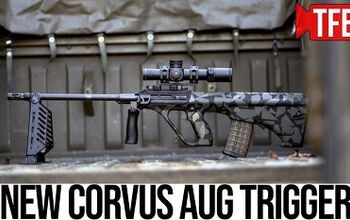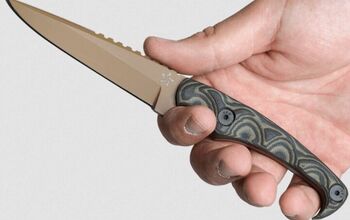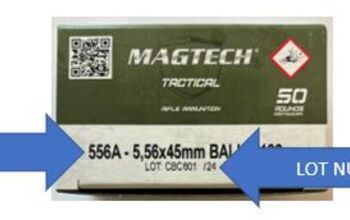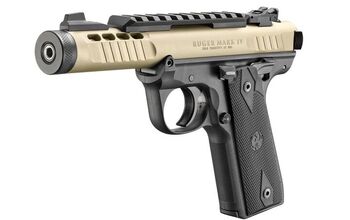6Silencer Saturday #366: SHOT Show Suppressor Roundup

Welcome back to Silencer Saturday, sponsored by Yankee Hill Machine, creators of the new Victra-12 shotgun suppressor. SHOT Show has come to an end and this is a good opportunity to talk about what was new in a more global sense. We have published many articles and videos about the various new suppressors and their specs, and we are not going to rehash those in deep detail. Rather, we are going to look at the trends across the industry as a whole.
Silencer Saturday @ TFB:
- Silencer Saturday #365: New Angstadt Arms Suppressors at SHOT 2025
- Silencer Saturday #364: New Design From Contra Cans
- Silencer Saturday #362: Liberty Suppressors 10/22 IDF Clone
- Silencer Saturday #361: Hunting With Suppressors
- Silencer Saturday #360: Suppressing The Beretta Cheetah
Additive Manufacturing
I had previously predicted that we would see more 3D-printed silencers this year, and that prediction was very accurate. Almost every new suppressor design on display was made using additive manufacturing. Although additive manufacturing has not fully replaced all other methods of construction, it was clear that the bulk of new designs are moving this way.
These silencers are not made with the kind of 3D printers many hobbyists have at home, though. Most of those printers either melt a filament and draw in stacking layers or use liquid resin by curing select portions with UV light. The most common type of machine for silencer construction is Direct Metal Laser Sintering (DLMS). That technology takes a very fine metal powder and uses a laser to melt it into layers. The resulting part does not have weak points like weld seams because the microscopic metal pieces are very uniform and melt into consistent layers that behave more like a single piece.
One of the advantages of printing over machining is the ease of building new designs. Unlike a CNC machine, which requires careful planning and tool routing to create a design, printers require very little human involvement to create a new design. Engineers can take a design, make a tweak, and print out a new test item. Some of those versions will be improvements; others will not. But the ease of creating new designs is leading to more experimentation.
Silencers made with additive manufacturing can use more complex internal designs. Take for example the Dead Air Sandman X. It uses a “Triskelion” design for a portion of the baffle stack. It is a kind of helix that traps gasses differently than a conical baffle. Another example is found in the the gas routing ports along the outside of the AAC Ranger 5 RBP, the unique baffle structure inside the BOE Suppression cans, and the “Purposely Induced Porosity” of the PTR Vent Spiritus and Dillon Rifle Company .50 BMG silencer. In time we will likely see even more new and creative ways of applying this technology.
Haynes 282
One unexpected new trend is the use of Haynes 282. Most current-production silencers are made of steel, titanium, or Inconel, or some combination of those materials. Steel and titanium show up in all kinds of things outside the gun world, and most silencer fans are already familiar with Inconel. But Haynes 282 is much newer, and previously only found in one or two silencers like the Dead Air Lazarus 6. It is used in other industries to make things like high pressure boilers and rocket engine nozzles.
I am planning a full Silencer Saturday about this material, but suffice it to say it is extremely heat-resistant and the host gun would probably melt before a suppressor made of Haynes. Silencers from AAC, Radical Firearms, and Dead Air all use Haynes 282. All are made with additive manufacturing.
Universal Mounting
Silencers are increasingly moving away from proprietary mounting. Most of the new releases at SHOT Show have HUB mounting. The “Hybrid Universal Base” or Hub mounts use 1.375x24 threads in the rear of the silencer. Most manufacturers are incorporating Hub threads in their designs, even if they also use some form of proprietary quick detach mount. There can be some downsides to this style of mount because the manufacturer does not have full control over mounting device, and using a muzzle device that was never tested with a silencer could lead to worse performance, or tolerance stacking that leads to an end cap strike (and with no clear way to point the finger, because the silencer manufacturer and muzzle device manufacturer will both point fingers at each other).
Along with the myriad new silencers that have Hub threads, Surefire had a new adapter offering. It attaches to a silencer with Hub mounting and allows it to mount on a gun with a Surefire muzzle device. This Fast Attach Hub Mount adds Surefire to the very long list of manufacturers that have brought their products into the Hub sphere.
That’s it for this edition of Silencer Saturday. Be sure to check out all of our coverage from SHOT Show across the website and the TFBtv and TFBtv Show Time channels.
SILENCER SHOP – HANSOHN BROTHERS – DEADEYE GUNS
MAC TACTICAL
ALL YHM PRODUCTS AT BROWNELLS
DEALERS: If you want your link to buy YHM suppressors included in future Silencer Saturday posts, email: silencers@thefirearmblog.com
Silencer Shop is the official NFA Partner of The Firearm Blog.

AKA @fromtheguncounter on Instagram. Gun nerd, reloader, attorney, and mediocre hunter.
More by Daniel Y



























Comments
Join the conversation
Surefire making the HUB adapter wasn't on my 2025 bingo card. Thats pretty cool.
Radical Defense has been using Hanyes 282 for years. Dead Air doesn't make squat. It's a marketing company that farms out R&D and production. Give credit where credit is due.